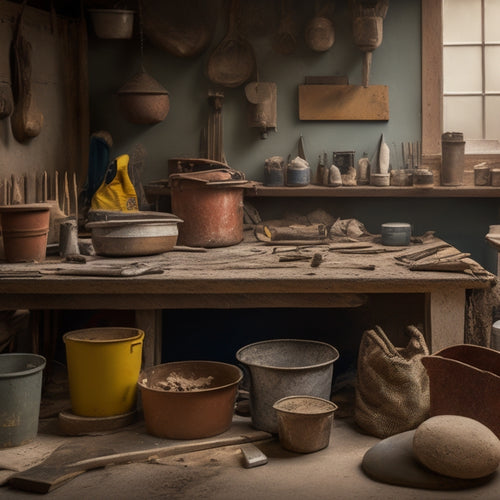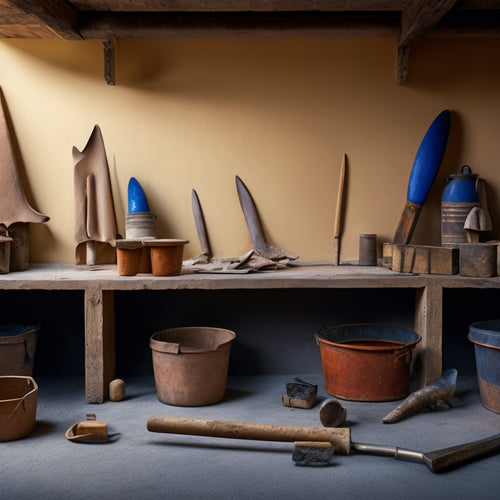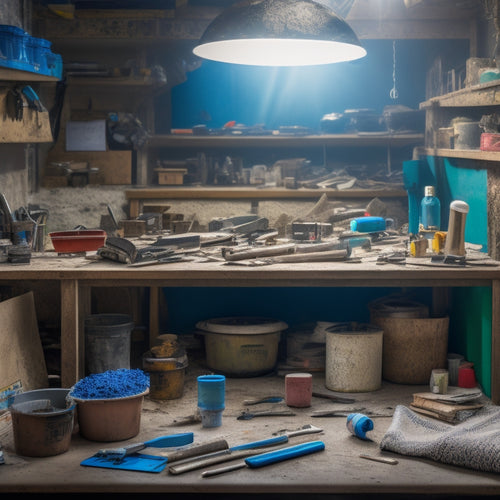
Top Trowels for Beginners in Home Renovation
Share
You'll need a reliable trowel to achieve professional-looking results in your home renovation project. As a beginner, it's crucial to choose the right type of trowel, considering factors like material, durability, and project requirements. For concrete block work, the Marshalltown 12-inch x 4-inch Concrete Block Trowel is a great option, with its high-carbon steel blade and comfortable handle. For finishing work, opt for a stainless steel or high-carbon steel blade trowel for smooth, even finishes. To get started on the right foot, prioritize trowel selection, maintenance, and care, and you'll be well on your way to achieving exceptional results - and with the right guidance, you'll reveal even more secrets to success.
Key Takeaways
• For beginners, choose a trowel with a comfortable, contoured handle to reduce fatigue and improve control.
• Select a trowel with a high-carbon steel or stainless steel blade for durability and rust resistance.
• Consider a trowel with a notch angle between 30°-45° for general-purpose applications and finishing work.
• Marshalltown's 12-inch x 4-inch Concrete Block Trowel is a recommended model for beginners, offering a comfortable handle and durable blade.
• Practice proper techniques, such as using a level and applying the right amount of pressure, to achieve professional-looking results.
Choosing the Right Trowel Type
Selecting the right trowel type is essential, as it directly impacts the quality of your work and can make a significant difference in the efficiency of your projects.
You'll want to evaluate the trowel materials, as they affect the tool's durability and performance. For instance, stainless steel trowels are ideal for working with epoxy or polyurethane-based adhesives, while carbon steel trowels are better suited for general-purpose use. Additionally, you'll need to think about trowel maintenance, as regular cleaning and lubrication can extend the lifespan of your tool.
When choosing a trowel, you should also assess the project's specific requirements. For example, if you're working with large, heavy materials, you'll need a trowel with a sturdy handle and a robust blade. On the other hand, if you're working on smaller, more intricate projects, a lighter, more agile trowel may be more suitable.
Best Concrete Block Trowel for Beginners
As a beginner, you'll want to invest in a concrete block trowel that can handle the demands of heavy-duty applications, and the Marshalltown 12-inch x 4-inch Concrete Block Trowel is a top contender that fits the bill. This trowel is designed for laying concrete blocks, bricks, and other masonry units, making it perfect for your project. Its durable, high-carbon steel blade is built to withstand the rigors of heavy use, and its comfortable, contoured handle reduces fatigue.
When it comes to mastering concrete block techniques, having the right tool is crucial. Here's what you need to know about the Marshalltown 12-inch x 4-inch Concrete Block Trowel:
| Feature | Description |
|---|---|
| Blade Size | 12 inches x 4 inches |
| Material | High-carbon steel |
| Handle | Contoured, comfortable design |
With this trowel, you'll be able to achieve professional-looking results with ease. Remember, as a beginner, it's important to practice beginner masonry tips, such as using a level to guarantee straight lines and applying the right amount of mortar to the block. With the Marshalltown 12-inch x 4-inch Concrete Block Trowel and some practice, you'll be well on your way to becoming a masonry expert.
Selecting the Perfect Finishing Trowel
When you're ready to add the final touches to your masonry project, you'll need a finishing trowel that can provide a smooth, even finish, and that's where the right tool makes all the difference.
A high-quality finishing trowel will allow you to refine your finishing techniques, ensuring a professional-looking result. Look for a trowel with a stainless steel or high-carbon steel blade, as these materials will hold their shape and resist corrosion.
The handle should be comfortable and balanced, allowing for precise control and reduced fatigue. Regular trowel maintenance is also essential, so make sure to clean and dry your trowel after each use to prevent rust and extend its lifespan.
A well-maintained finishing trowel will reward you with a flawless finish, every time. By investing in the right finishing trowel and honing your techniques, you'll be able to achieve a level of mastery that will elevate your masonry projects to the next level.
Essential Features for Notched Trowels
When choosing a notched trowel, you'll want to pay close attention to the notch angle, as it directly affects the amount of compound you can hold and the resulting finish.
You'll also need to take into account the trowel's size, as it impacts the area you can cover and the level of precision you can achieve.
Notch Angle Matters
You'll find that the notch angle of a trowel greatly impacts the amount of material it can hold and release, making it a critical consideration when selecting the right tool for your project.
A steeper notch angle, typically between 45° to 60°, is ideal for holding and releasing larger amounts of material, making it suitable for applying thick layers of adhesive or mortar. On the other hand, a shallower notch angle, typically between 30° to 45°, is better suited for spreading thin layers of material, making it ideal for finishing work or applying skim coats.
When choosing a notched trowel, consider the specific requirements of your project and the type of material you'll be working with. It's important to maintain your trowel properly to guarantee peak performance.
Regularly clean your trowel and store it in a dry place to prevent rust or corrosion. Regarding trowel usage techniques, practice holding the trowel at the correct angle and applying the right amount of pressure to achieve a smooth, even spread.
Trowel Size Importance
Selecting the right trowel size is vital, as it directly affects the efficiency and quality of your work, particularly when applying adhesive or mortar to large surfaces. A trowel that's too small will require more strokes, increasing the risk of uneven application and fatigue.
On the other hand, a trowel that's too large can be cumbersome, making it difficult to maneuver in tight spaces.
When choosing a trowel size, take into account the surface area you'll be working on and the type of material you're applying. A larger trowel (12-14 inches) is ideal for big projects, such as laying tile or applying drywall compound, while a smaller trowel (8-10 inches) is better suited for smaller tasks, like patching holes or applying adhesive to trim.
It's also significant to evaluate the trowel weight and balance. A well-balanced trowel with an ideal weight distribution will reduce fatigue and improve control.
Look for a trowel that feels comfortable in your hand, with a weight that's not too heavy or too light. By selecting the right trowel size, you'll be able to work efficiently and effectively, achieving professional-quality results in your home renovation projects.
Top-Rated V-Notch Trowels for Walls
For applying and spreading plaster, stucco, or texture materials on walls, V-notch trowels are the go-to tools, and choosing the right one can make all the difference in achieving a smooth, even finish. As a beginner, you'll want to invest in a high-quality V-notch trowel that can handle various V-notch applications with ease.
When selecting a V-notch trowel, consider the following key factors:
-
Trowel material: Stainless steel or high-carbon steel trowels are ideal for durability and rust resistance.
-
Notch size and spacing: A trowel with evenly spaced notches (usually 1/4 inch or 1/2 inch) will help you achieve a consistent texture.
-
Handle comfort: Look for a trowel with a comfortable, ergonomic handle that reduces fatigue during extended use.
Proper trowel maintenance is also essential to extend the life of your tool. Regularly clean your trowel with soap and water, and apply a rust inhibitor to prevent corrosion.
Understanding Trowel Handle Materials
When selecting a trowel, you'll want to take into account the handle material, as it greatly impacts the tool's overall performance and your comfort while working.
You'll need to weigh the benefits of wood handles, which offer a comfortable grip and can reduce fatigue, against the durability of metal handles, which can withstand heavy use and harsh job site conditions.
Wood Handle Benefits
You'll find that wood handle trowels offer a more comfortable grip, as the natural texture and warmth of the wood conform to your hand over time. This ergonomic design allows for reduced fatigue and improved control, making it ideal for beginners.
As you work with your wood handle trowel, you'll appreciate the subtle give and take of the wood, which absorbs shock and vibrations, reducing the impact on your hand and wrist.
To get the most out of your wood handle trowel, keep the following tips in mind:
-
Regularly clean and dry the handle to prevent moisture buildup and wood rot
-
Apply a wood conditioner or oil to maintain the wood's natural texture and prevent cracking
-
Store your trowel in a dry place, away from direct sunlight, to prevent warping or discoloration
Metal Handle Durability
Metal handle trowels boast unparalleled durability, with their rugged, rust-resistant materials standing up to the rigors of heavy use and harsh job site conditions.
As you work on your renovation project, you'll appreciate the reliability of a metal handle trowel, which can withstand the toughest tasks without compromising its performance.
One of the primary benefits of metal handles is their resistance to wear and tear, ensuring that your trowel remains functional even after repeated use.
Additionally, metal handles require minimal maintenance, as they're less prone to splintering, cracking, or absorbing moisture. This means you can focus on your project without worrying about your trowel's condition.
When it comes to metal handle maintenance, a simple wipe-down with a dry cloth after each use is usually sufficient. You may also apply a rust-inhibiting coating to further extend the handle's lifespan.
Popular Trowel Sizes for Homeowners
Selecting the right trowel size is essential for efficiently completing your project. Homeowners often find themselves opting for sizes between 11 and 18 inches, depending on the scope of the job and personal comfort.
You'll want to take into account the area you're working on, the type of material you're applying, and your own physical comfort when choosing a trowel size. A larger trowel may be necessary for bigger projects, but it can be cumbersome and lead to fatigue. On the other hand, a smaller trowel may be more manageable, but it may require more strokes to cover the same area.
To avoid common trowel mistakes, keep the following in mind:
-
Using a trowel that's too small for the job, leading to inefficient work and fatigue.
-
Neglecting trowel maintenance tips, such as cleaning and storing your trowel properly, which can affect its performance and longevity.
-
Failing to take into account the material you're working with, which can affect the trowel size and type you need.
Budget-Friendly Trowel Options Available
Five affordable trowel options are available on the market, catering to beginners who want to get started with their projects without breaking the bank.
As a DIY enthusiast, you don't have to sacrifice quality for affordability. Brands like Marshalltown, Kraft, and Goldblatt offer reliable and durable trowels at an affordable price point.
The Marshalltown 12-inch x 4-inch V-Notch Trowel, for instance, is a popular choice among beginners. It features a sturdy aluminum alloy handle and a notched blade perfect for applying and spreading adhesive.
When shopping for an affordable trowel, look for brands that prioritize quality and durability. Kraft's 11-inch x 4-inch Pointing Trowel is another great option, featuring a rust-resistant blade and a comfortable handle.
Goldblatt's 12-inch x 4-inch V-Notch Trowel is also a great choice, offering a lightweight design and a precision-notched blade.
These affordable trowel brands are essential DIY renovation essentials, providing you with the tools you need to complete your projects successfully.
Safety Precautions for Trowel Users
When handling a trowel, you must prioritize your safety above all else, as the tool's sharp edges and pointed notches can cause serious cuts and injuries if not handled properly. A single misstep can lead to user injuries, which can be debilitating and even career-ending for professionals. To avoid such mishaps, it's vital to follow safety guidelines and best practices.
Here are some important safety precautions to keep in mind:
-
Wear protective gear: Always wear heavy-duty gloves, safety glasses, and a dust mask when working with a trowel to prevent cuts, splinters, and respiratory issues.
-
Maintain proper trowel ergonomics: Hold the trowel with a firm, comfortable grip, keeping your wrists straight and your arms relaxed to avoid fatigue and strain.
-
Keep your workspace clean and clear: Make certain your work area is free from debris, wires, and other obstacles to prevent tripping and slipping hazards.
Frequently Asked Questions
Can I Use a Trowel for Both Concrete and Drywall Projects?
When deciding if you can use a trowel for both concrete and drywall projects, consider the trowel types and application techniques involved.
While you can use a single trowel for both, it's not recommended. Concrete trowels are typically heavier, with a more aggressive edge, whereas drywall trowels are lighter, with a smoother edge.
Using the wrong trowel can lead to subpar results. To achieve mastery, it's best to invest in separate trowels, each designed for its specific application, ensuring superior results in both concrete and drywall projects.
How Often Should I Clean My Trowel During a Project?
Like a surgeon with a scalpel, you wield your trowel with precision - but even the finest tools require TLC.
During a project, you should clean your trowel every 30 minutes to an hour to prevent dried material buildup. Use a wire brush to scrape off excess, then wipe with a damp cloth.
Regular trowel maintenance is key to ensuring a smooth finish and prolonging its lifespan.
Are Trowels Suitable for Applying Adhesive or Thinset?
When it comes to applying adhesive or thinset, you'll want to choose the right trowel type for the job.
V-notch trowels are ideal for adhesive application, as they allow for precise control and even distribution.
On the other hand, square-notch or U-notch trowels are better suited for thinset application, as they can handle thicker mixtures and provide more coverage.
You'll achieve professional-looking results by selecting the correct trowel for the specific task at hand.
Can I Use a Trowel to Mix and Apply Compound?
When it comes to mixing and applying compound, you'll want to choose the right trowel type for the job.
A mixing trowel or a hawk trowel is ideal for combining materials, as they've a flat, broad blade and a comfortable grip.
Use a gentle, sweeping motion to mix the compound, then switch to a finishing trowel with a notched or rounded edge to apply it smoothly.
Mastering these mixing techniques will guarantee a professional-looking finish.
Do I Need to Wear Gloves When Using a Trowel?
When working with a trowel, you'll want to prioritize trowel safety to avoid injuries and guarantee efficient results.
Wearing gloves is highly recommended, as they provide numerous benefits. Gloves will protect your hands from abrasive materials, prevent blisters, and improve grip, allowing for better control over the trowel.
Additionally, gloves will keep your hands clean and dry, reducing the risk of slipping and dropping the tool.
Conclusion
As you venture into the world of home renovation, remember that the right trowel can make all the difference.
You've got the know-how, now it's time to put it to the test.
But, be warned: with great trowel power comes great responsibility.
Choose wisely, and your walls will thank you.
But, choose poorly, and you'll be left with a mess that'll haunt you for years to come.
The fate of your renovation project hangs in the balance - will you rise to the challenge?
Related Posts
-

What Plastering Tools Do You Need for Renovation
You'll need a range of specialized tools to tackle a plastering renovation project efficiently and effectively. Essen...
-

7 Best Plastering Bat Sizes for DIY Renovations
When tackling DIY renovations, you'll want to choose the right plastering bat size to achieve a professional-looking ...
-

Get Discounted Plastering Tool Sets for DIY Renovations
You can find discounted plastering tool sets online, at local hardware stores, and thrift stores, offering a range of...


